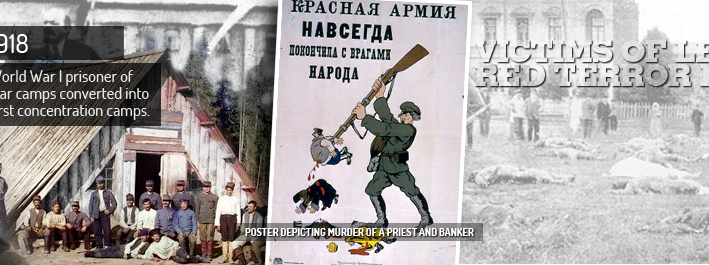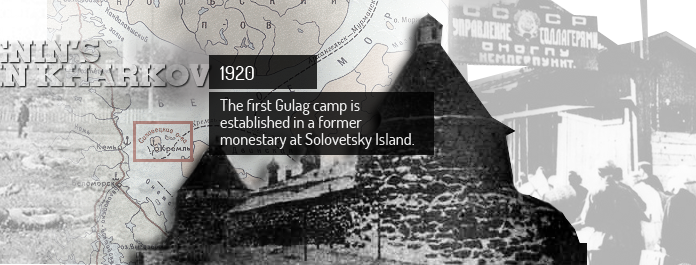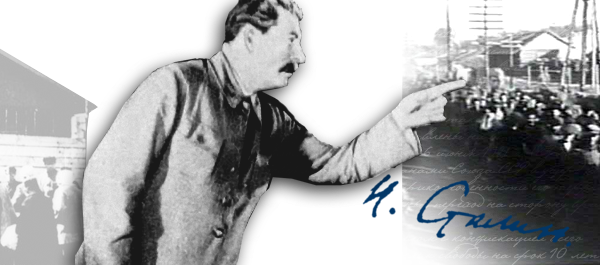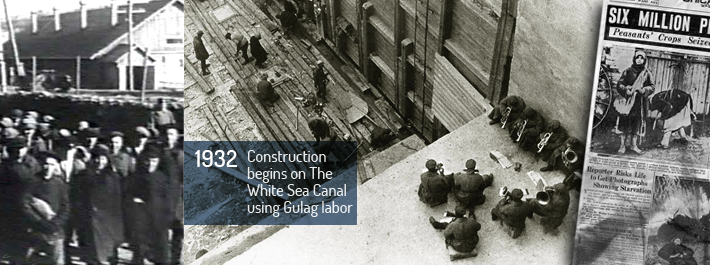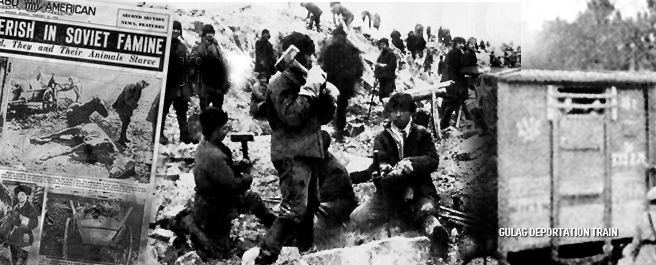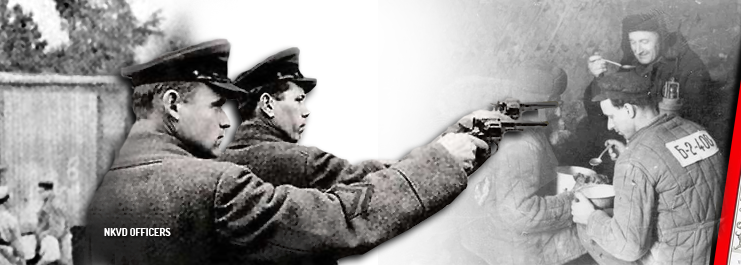A new type of criminal, "class enemy", is created by the Bolsheviks.
The Bolshevik, secret police or Cheka, is established by Felix Dzerzhinsky
Revolutionary tribunals begin convicting 'enemies' of the revolution. Punishment includes forced labor
The Bolshevik, secret police or Cheka, is established by Felix Dzerzhinsky

1917-1920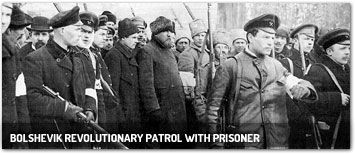
Prisons overflow with arbitrarily arrested citizens deemed to be enemies of the revolution. New and overflow prisoners are confined in churches, basements, attics and other random locations, usually without furniture, adequate supplies and little food.
In a memorandum, Trotsky calls for the creation of new outdoor prisons called kontslagers or concentration camps in remote regions, to be populated the city and village bourgeois engaged in forced menial labour.
Lenin orders mass terror against wealthy kulak peasants, White Guards and members of the clergy who would be sent to remote concentration camps.
First World War prisoner of war camps (now under the control of Dzerzhinsky's Cheka,) are converted into the first concentration camps. These are the first camps of the GULAG.
Dzerzhinsky is ordered to carry out The Red Terror. A merciless wave of arrests and murder. The concentration camps, now referred to as Special Camps play a critical role in the terrors.
The notorious Gulag camp at the converted Solovetsky Monestary is established in the far north west of Russia's arctic. The first such prison created specifically by the Cheka/OGPU for their vision of concentration camps - now called SLON ('northern camps of special significance').
Of the 6000 prisoners at Solovetsky, 1/4 die of illness caused by poor conditions and overwork.

Conditions at Solovetsky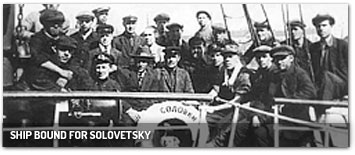
A report by a Soviet government commission details a horrific regime of torture at the camp - inmates were, for example, arbitrarily made to stand naked in outside in freezing weather; intentionally crippled, made to swim in rivers in mid winter. Random mass executions were also a common practice. OGPU leaders decide to expand the camp system to other remote regions.
A food-for-work system is implemented in the camps.

Conditions at Solovetsky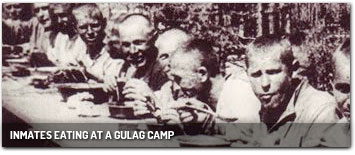
Workers were required to fulfill specific (usually unrealistically high) work quotas in order to receive their portion of daily rations - a small portion of bread and small piece of meat.
Healthy prisoners had higher requirements whereas sick patients had lower ones and received little food. This system quickly caused widespread starvation across the camps but was maintained through the 1950's.
Soviet criminal code is rewritten to include an expanded Article 58 which includes 'counter-revolutionary' crimes which would be applied to terrifying, arbitrary effect thought the coming decades.

ARTICLE 58
Article 58 of the Russian SFSR Penal Code was put in force on 25 February 1927 to arrest those suspected of counter-revolutionary activities. Subsection 1 defines "a counter-revolutionary action is any action aimed at overthrowing, undermining or weakening of the power of workers' and peasants' Soviets... and governments of the USSR and Soviet and autonomous republics, or at the undermining or weakening of the external security of the USSR and main economical, political and national achievements of the proletarial revolution" More on Article 58.
The term 'concentration camp' is no longer used by Soviet authorities due to pressure by western powers, but not about the treatment of prisoners but the economic threat posed by the mass use of slave labour in the Soviet Union.
Millions die during the Soviet manufactured famine. Ukranians from all walks of life are arrested and deported to the Gulag. During the 1930's, up to 1/4 of the Gulag population is Ukranian.
The geographic expansion of the camps to the far east, in Kolyma; to the far north in Komi and south in Kazakhstan is in full swing.
The Gulag becomes a primary economic engine for the Soviet Union under the control of the now renamed, NKVD.
Thousands of Americans who emigrated to The Soviet Union to work in the automotive industry are arrested and sent to the camps.

AMERICANS IN THE GULAG
During the Great Depression, thousands of Americans emigrated to the USSR. Some were communists and socialists, others were simply looking for work. Upon arrival, in the early 1930's, Soviet authorities generally stripped the Americans of their passports. At the height of the Great Terror, most were arrested and many were sent to the Gulag. Americans who appealed to US Ambassador Joseph Davies for help were ignored. Davies stated in a 1937, Time magazine article, that “The Soviet Union is doing wonderful things.”
The term 'enemy of the people' becomes an officially used term referring to anyone who 'commits sabotage' or anyone who 'doubts the rightness of the Party line.' The number of prisoners continues to explode.
Thousands of new prisoners arrive from the Soviet occupied territories in Poland, Estonia, Lithuania and Latvia, where widespread arrests and deportations of members of the political, academic and business communities.
Polish inmates are granted a tenuous amnesty.

POLISH PRISONERS GRANTED AMNESTY
Inmates with Polish citizenship are granted a tenuous amnesty, allowing them to join a Soviet sanctioned Polish army unit led by Polish General Anders. However, only those Polish citizens with Polish heritage are granted amnesty. Many camp commanders refused to grant amnesty. The memoirs and recollections of those Polish survivors provide the bulk of information available about living conditions in the camps.
Production in the camps is shifted to support the Soviet war effort. Conditions in the camps worsen as starvation becomes rampant.
New repressive laws are implemented in the Soviet Union to combat the threat of democracy. Campaigns against ethnic minorities intensify, including Soviet Jews.

STALIN'S DEATH
News is received in the camps to mixed reaction: many feared additional sentences if they displayed any emotion. Rumors about the fate of prisoners causes mass confusion. Many in the camps openly weep, believing that Stalin was their only hope for release: many had written to Stalin explaining that they were falsly convicted and imprisioned and believed that Stalin would correct the situation by releasing them.
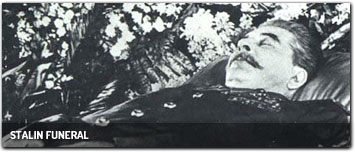
Prisoners strike in many camps. Guards execute many of those who participate. JULY 1954 After strikes and revolts in some camps, the camp regime was relaxed.
Khruschev delivers his secret speech condemning Stalin. An increasing number of prisoners are released.
Aleksandr Solzhenitsyn's 'One Day in the Life of Ivan Denisovich' becomes the first published memoir of life in the camps.
Instead of arresting political dissidents, many are sent to psychiatric hospitals for 'rehabilitation.' However, most are simply subjected to a wide range of forced treatments and experiments.
The Communist Party is put on trial, where former Gulag inmate, Vladimir Bukhovsky, testifies about Soviet repressions.
New school textbooks are issued in Russia. None mention the Gulag or Stalin's repressions. The book cites Stalin is a hero. A survey of Russians places Stalin as the greatest Russian in history. News Links: Helsinki Sanomat on Stalin Textbooks Daily Mail on Stalin Textbooks
Memorial, an organization established to investigate past Soviet repressions, is targeted by current Russian authorities for investigation. Most of their archival hard drives are confiscated. News Links: Letter by Orlando Figes


